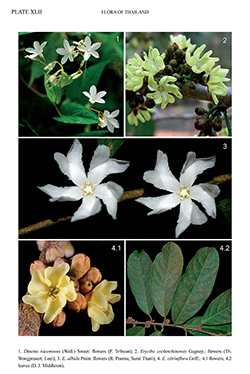e-Flora of Thailand
Volume 10 > Part 3 > Year 2010 > Page 390 > Convolvulaceae > Erycibe
3. Erycibe cochinchinensis Gagnep.wfo-0000156425
Not. Syst. 3: 138. 1915 & in Lecomte, Fl. Indo-Chine 4: 308. 1915; Kerr, Fl. Siam. Enum. 3(1): 94. 1951; Hoogland, Blumea 7: 345. 1953; Plate XLII: 2.
Accepted Name : This is currently accepted.
Description : Woody climber or treelet to 6 m tall; stems terete, greyish, twigs glabrous. Leaves oblong-elliptic to oblong-oblanceolate, 9–19 by 3–7 cm, coriaceous, drying reddish, base acute, apex obtuse or acuminate; lateral veins 7 or 8, curved near margin, slightly raised on underside; petiole 10–15 mm long, glabrous. Inflorescences dense, axillary, glomerules up to 2 cm long; pedicels 3 mm long. Flowers fragrant; sepals orbicular, equal, ca 3 mm diam., reddish hairy outside; corolla yellow, ca 9 mm long, lobes deeply bilobed, lobules entire; stamen filaments shorter than anther, anthers ovoid-acuminate, 1.7 mm long, scales 5, inserted between filaments at base of corolla tube; ovary subglobose, 2-celled. Berry ellipsoid, 20 by 10–12 mm, ripening yellow-orange.
Thailand : NORTHERN: Lampang, Uttaradit; NORTH-EASTERN: Nong Khai, Nakhon Phanom; EASTERN: Nakhon Ratchasima; SOUTH-EASTERN: Sa Kaeo, Prachin Buri, Trat.
Distribution : Laos (syntype), Cambodia, Vietnam (syntype).
Ecology : Dry, disturbed evergreen forests, mixed evergreen forests, on sandstone bedrock, ca 200–300 m alt. Flowering: February–March; fruiting: April–May.
Vernacular : Thao si phueng (เถาสีผึ้ง)(Sa Kaeo); ka tit (กาติด)(Northeastern).
Notes: The berries are reported to be edible, sweet, and eaten locally (Put 92).

